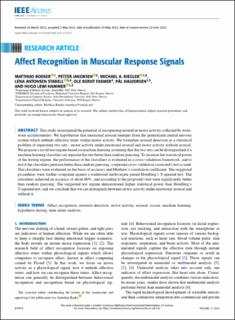| dc.contributor.author | Boeker, Matthias | |
| dc.contributor.author | Jakobsen, Petter | |
| dc.contributor.author | Riegler, Michael | |
| dc.contributor.author | Stabell, Lena Antonsen | |
| dc.contributor.author | Fasmer, Ole Bernt | |
| dc.contributor.author | Halvorsen, Pål | |
| dc.contributor.author | Hammer, Hugo Lewi | |
| dc.date.accessioned | 2023-10-26T05:23:26Z | |
| dc.date.available | 2023-10-26T05:23:26Z | |
| dc.date.created | 2023-08-23T14:38:08Z | |
| dc.date.issued | 2023 | |
| dc.identifier.citation | IEEE Access. 2023, 11 61914-61928. | en_US |
| dc.identifier.issn | 2169-3536 | |
| dc.identifier.uri | https://hdl.handle.net/11250/3098821 | |
| dc.description.abstract | This study investigated the potential of recognising arousal in motor activity collected by wrist-
worn accelerometers. We hypothesise that emotional arousal emerges from the generalised central nervous
system which embeds affective states within motor activity. We formulate arousal detection as a statistical
problem of separating two sets - motor activity under emotional arousal and motor activity without arousal.
We propose a novel test regime based on machine learning assuming that the two sets can be distinguished if a
machine learning classifier can separate the sets better than random guessing. To increase the statistical power
of the testing regime, the performance of the classifiers is evaluated in a cross-validation framework, and to
test if the classifiers perform better than random guessing, a repeated cross-validation corrected t-test is used.
The classifiers were evaluated on the basis of accuracy and Matthew’s correlation coefficient. The suggested
procedures were further compared against a traditional multivariate paired Hotelling’s T-squared test. The
classifiers achieved an accuracy of about 60%, and according to the proposed t-test were significantly better than random guessing. The suggested test regime demonstrated higher statistical power than Hotelling’s
T-squared test, and we conclude that we can distinguish between motor activity under emotional arousal and without it. | en_US |
| dc.language.iso | eng | en_US |
| dc.rights | Attribution-NonCommercial-NoDerivatives 4.0 Internasjonal | * |
| dc.rights.uri | http://creativecommons.org/licenses/by-nc-nd/4.0/deed.no | * |
| dc.title | Affect Recognition in Muscular Response Signals | en_US |
| dc.type | Peer reviewed | en_US |
| dc.type | Journal article | en_US |
| dc.description.version | publishedVersion | en_US |
| cristin.ispublished | true | |
| cristin.fulltext | original | |
| cristin.qualitycode | 1 | |
| dc.identifier.doi | 10.1109/ACCESS.2023.3279720 | |
| dc.identifier.cristin | 2169082 | |
| dc.source.journal | IEEE Access | en_US |
| dc.source.volume | 11 | en_US |
| dc.source.pagenumber | 61914-61928 | en_US |

